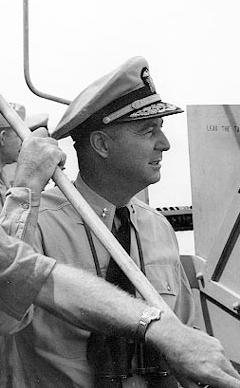![]() The Pacific War Online Encyclopedia
The Pacific War Online Encyclopedia
|
| Previous: Concrete | Table of Contents | Next: Conscription |

"Close-In" Conolly ("Dick" to his friends) received his nickname from his insistence that fire-support ships should maneuver extremely close to the beach during amphibious assaults. Ship commanders feared running aground, but Conolly understood that strong beach fortifications could be neutralized only by direct hits, and direct hits could be reliably achieved only from the shortest possible range.
Conolly was a 1914 Naval Academy graduate with a background in destroyers. He had received the Navy Cross for the salvage of Westbridge after she was torpedoed by a U-boat in August 1918: "... when he, with a party of eight others remained on board for five days steering by hand and handling the lines from the tugs, while the ship was towed four hundred miles to port."
As a destroyer flotilla commander, Conolly
participated in the Doolittle
Raid. Later, as a Washington staff officer, he was one of the few
who believed TORCH (the landings in North Africa) would succeed. He
directed amphibious invasions
in the Mediterranean
before taking command of the Northern Force responsible for the
invasion of Makin
during the Gilberts
campaign. He initially clashed with Turner, who felt there
was only room for one amphibious expert in the Pacific, but the two men
developed a grudging respect for each other. Conolly continued to
command amphibious forces within
5 Fleet for the
remainder of the war. Spruance
particularly commended him for his resourcefulness during the Roi-Namur invasion.
Conolly was in Washington when Turner was up for a third star. Some senators were balking on the promotion because of the Savo Island disaster, but Conolly put in a good word for Turner that may have helped put the promotion through.
Conolly was "[r]obust and genial, thorough and
methodical" (Morison 1953) and a careful planner as well as a tough
fighter. A charming, personable officer, he worked well with Marine
officers such as Geiger. His
chief of staff, Charles Wellborn, later said of him:
I've served with a lot of fine officers but he seemed to have the best perception of all as to what the role of a commander was, what the role of his chief of staff was, and what the role of each one of his staff officers was. He seemed to know better than most how to fire up a team, to have them at the peak on the day of the operation. He didn't have the brightest mind of all the people I worked with — but he had an understanding of leadership that I thought was outstanding... He was outgoing and a scrapper. As a wartime leader he had the right natural equipment and knew how to use it.
(Tuohy 2007)
| 1892-4-26 |
Born at Waukegan, Illinois |
|
| 1914 |
Ensign |
Graduates from Naval Academy.
Assigned to BB Virginia |
| 1915-5 |
BB Montana for torpedo
instruction |
|
| 1915-11 |
BB Virginia | |
| 1916-3 |
BB Vermont | |
| 1916-5 |
DD
Smith |
|
| 1918-11 |
Navy Postgraduate School,
Annapolis, and Columbia University, New York (Master of Science) |
|
| 1922-11 |
BB Mississippi |
|
| 1924-3 |
BB New
York |
|
| 1925-9 |
Instructor, Naval Academy |
|
| 1927-6 |
CL Concord |
|
| 1929-8 |
Commander, Dupont |
|
| 1930 |
Navy War College |
|
| 1931-5 |
Instructor, Navy War College |
|
| 1933-5 |
Flag secretary, Cruisers, Scouting Force |
|
| 1935-4 |
Tennessee |
|
| 1936-6 |
Instructor, Naval Academy |
|
| 1939-5 |
Commander, Destroyer Division 7 |
|
| 1941-10 |
Captain |
Commander, Destroyer Squadron 6 |
| 1942-6 |
Staff, Navy Department |
|
| 1943-6 |
Rear
admiral |
Commander, Landing Craft and Base,
Northwest African Waters |
| 1943-10 |
Commander, Amphibian
Group 4 |
|
| 1944-6 |
Commander, Amphibian
Group 3 |
|
| 1946-9-23
|
Admiral |
Commander, U.S. Naval Forces
Europe |
| 1962-3-1 |
Killed in an air crash along
with his wife |
References
Arlington Cemetery Website (accessed 2008-2-10)
Naval
Historical
Center (accessed 2008-2-10)
Pettibone (2006)
The Pacific War Online Encyclopedia © 2007-2009 by Kent G. Budge. Index